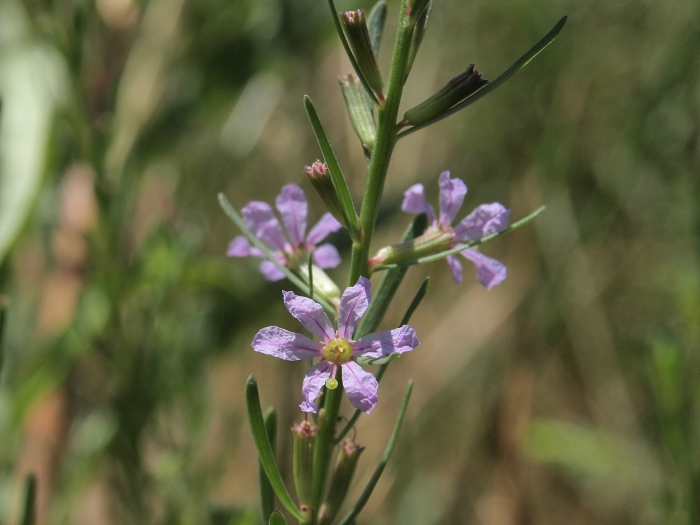California Loosestrife
(Lythrum californicum)
California Loosestrife (Lythrum californicum)
/
/

Jim Morefield
CC BY 4.0
Image By:
Jim Morefield
Recorded By:
Copyright:
CC BY 4.0
Copyright Notice:
Photo by: Jim Morefield | License Type: CC BY 4.0 | License URL: http://creativecommons.org/licenses/by/4.0/ | Rights Holder: Jim Morefield | Publisher: iNaturalist | Date Created: 2018-08-18T10:44:36-07:00 |







































Estimated Native Range
Summary
Lythrum californicum, commonly known as California Loosestrife, is a deciduous subshrub or herbaceous perennial native to wetland areas, including riparian zones, marshes, and vernal pools, primarily in California and the Southwestern United States and parts of Mexico. It typically grows to a height of 20 to 60 cm (7.9 to 23.6 in) and may branch occasionally. The plant’s waxy, linear to lance-shaped leaves are oppositely arranged at the base and alternate towards the top. The inflorescence is a terminal spike with showy purple petals, each less than a centimeter long. The flowers exhibit heterostyly, with some having long, protruding styles and others with shorter styles that do not protrude from the flower’s mouth, an adaptation to promote cross-pollination.
California Loosestrife is valued for its attractive spikes of purple flowers that bloom from late spring through summer, adding color to water gardens, bog gardens, and naturalized areas. It is also used for habitat restoration projects. This plant thrives in part shade to full sun, prefers medium to wet soil conditions, and requires soils with good drainage. While it is relatively low-maintenance, it can spread aggressively if conditions are ideal, potentially outcompeting native species. Gardeners should monitor its growth to prevent unwanted spread.CC BY-SA 4.0
California Loosestrife is valued for its attractive spikes of purple flowers that bloom from late spring through summer, adding color to water gardens, bog gardens, and naturalized areas. It is also used for habitat restoration projects. This plant thrives in part shade to full sun, prefers medium to wet soil conditions, and requires soils with good drainage. While it is relatively low-maintenance, it can spread aggressively if conditions are ideal, potentially outcompeting native species. Gardeners should monitor its growth to prevent unwanted spread.CC BY-SA 4.0
Plant Description
- Plant Type: Subshrub, Herb
- Height: 0.7-3 feet
- Width: 2-2.5 feet
- Growth Rate: Moderate
- Flower Color: Purple
- Flowering Season: Spring, Summer, Fall
- Leaf Retention: Deciduous
Growth Requirements
- Sun: Full Sun, Part Shade
- Water: Medium
- Drainage: Medium, Fast
Common Uses
Bee Garden, Bird Garden, Butterfly Garden, Hummingbird Garden, Low Maintenance
Natural Habitat
native to wetland areas, including riparian zones, marshes, and vernal pools, primarily in California and the Southwestern United States and parts of Mexico
Other Names
Common Names: Hierba Del Cáncer
Scientific Names: , Lythrum californicum, Lythrum linearifolium, Lythrum alatum var. linearifolium, Lythrum album var. linearifolium,
GBIF Accepted Name: Lythrum californicum Torr. & A.Gray